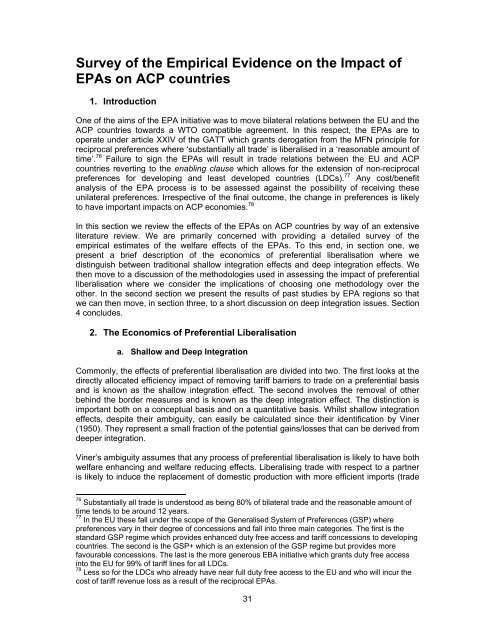EPA Review Annex Documents - DFID
EPA Review Annex Documents - DFID
EPA Review Annex Documents - DFID
Create successful ePaper yourself
Turn your PDF publications into a flip-book with our unique Google optimized e-Paper software.
Survey of the Empirical Evidence on the Impact of<br />
<strong>EPA</strong>s on ACP countries<br />
1. Introduction<br />
One of the aims of the <strong>EPA</strong> initiative was to move bilateral relations between the EU and the<br />
ACP countries towards a WTO compatible agreement. In this respect, the <strong>EPA</strong>s are to<br />
operate under article XXIV of the GATT which grants derogation from the MFN principle for<br />
reciprocal preferences where ‘substantially all trade’ is liberalised in a ‘reasonable amount of<br />
time’. 76 Failure to sign the <strong>EPA</strong>s will result in trade relations between the EU and ACP<br />
countries reverting to the enabling clause which allows for the extension of non-reciprocal<br />
preferences for developing and least developed countries (LDCs). 77 Any cost/benefit<br />
analysis of the <strong>EPA</strong> process is to be assessed against the possibility of receiving these<br />
unilateral preferences. Irrespective of the final outcome, the change in preferences is likely<br />
to have important impacts on ACP economies. 78<br />
In this section we review the effects of the <strong>EPA</strong>s on ACP countries by way of an extensive<br />
literature review. We are primarily concerned with providing a detailed survey of the<br />
empirical estimates of the welfare effects of the <strong>EPA</strong>s. To this end, in section one, we<br />
present a brief description of the economics of preferential liberalisation where we<br />
distinguish between traditional shallow integration effects and deep integration effects. We<br />
then move to a discussion of the methodologies used in assessing the impact of preferential<br />
liberalisation where we consider the implications of choosing one methodology over the<br />
other. In the second section we present the results of past studies by <strong>EPA</strong> regions so that<br />
we can then move, in section three, to a short discussion on deep integration issues. Section<br />
4 concludes.<br />
2. The Economics of Preferential Liberalisation<br />
a. Shallow and Deep Integration<br />
Commonly, the effects of preferential liberalisation are divided into two. The first looks at the<br />
directly allocated efficiency impact of removing tariff barriers to trade on a preferential basis<br />
and is known as the shallow integration effect. The second involves the removal of other<br />
behind the border measures and is known as the deep integration effect. The distinction is<br />
important both on a conceptual basis and on a quantitative basis. Whilst shallow integration<br />
effects, despite their ambiguity, can easily be calculated since their identification by Viner<br />
(1950). They represent a small fraction of the potential gains/losses that can be derived from<br />
deeper integration.<br />
Viner’s ambiguity assumes that any process of preferential liberalisation is likely to have both<br />
welfare enhancing and welfare reducing effects. Liberalising trade with respect to a partner<br />
is likely to induce the replacement of domestic production with more efficient imports (trade<br />
76<br />
Substantially all trade is understood as being 80% of bilateral trade and the reasonable amount of<br />
time tends to be around 12 years.<br />
77<br />
In the EU these fall under the scope of the Generalised System of Preferences (GSP) where<br />
preferences vary in their degree of concessions and fall into three main categories. The first is the<br />
standard GSP regime which provides enhanced duty free access and tariff concessions to developing<br />
countries. The second is the GSP+ which is an extension of the GSP regime but provides more<br />
favourable concessions. The last is the more generous EBA initiative which grants duty free access<br />
into the EU for 99% of tariff lines for all LDCs.<br />
78<br />
Less so for the LDCs who already have near full duty free access to the EU and who will incur the<br />
cost of tariff revenue loss as a result of the reciprocal <strong>EPA</strong>s.<br />
31
















